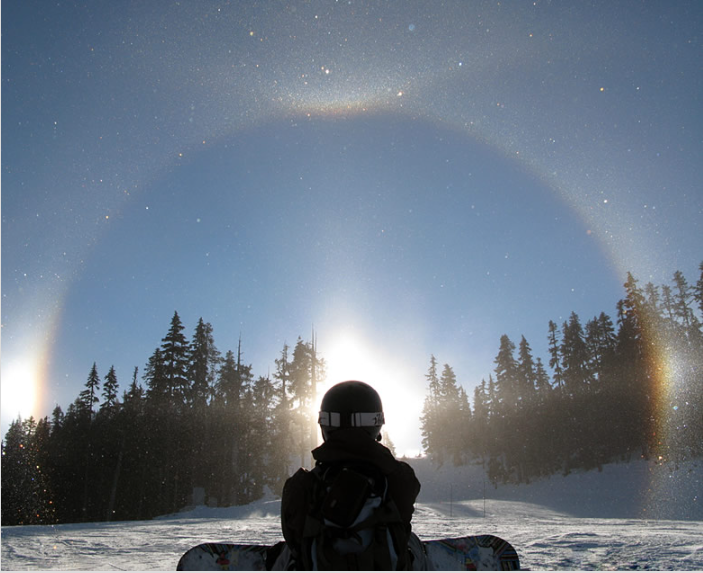Whistler Glints
Whistler Glints: A Captivating Atmospheric Optics Phenomenon
Whistler, Canada, is known for its breathtaking natural beauty, and occasionally, it treats lucky observers to a mesmerizing atmospheric optics display known as "Whistler Glints." These glints are a captivating manifestation of the interaction between sunlight and countless ice crystals suspended in the atmosphere. In this article, we will delve into the enchanting world of Whistler Glints and explore the various optical phenomena that contribute to this spectacle.
The Dance of Glints and Halos
When witnessing a Whistler Glints display, one is immediately struck by the ethereal beauty of the scene. What appears as a collection of shimmering glints is actually the culmination of millions of ice crystals reflecting and refracting sunlight. Whether these crystals are suspended in the air as diamond dust or scattered in high-altitude clouds, their collective presence creates an awe-inspiring spectacle.
Sundogs, Parhelic Circles, and More
At Whistler, Canada, Whistler Glints are often accompanied by a variety of other atmospheric optical phenomena. Sundogs, also known as parhelia, flank the sun on either side, forming luminous spots of light. These sunward-facing spots are caused by the refraction of sunlight through hexagonal ice crystals. Additionally, a parhelic circle, illuminated by crystals located in front of dark trees, may grace the sky. This circular band of light adds to the enchantment of the scene.
Pillars and Tangent Arcs
In some instances, observers may catch a glimpse of a pillar amidst the Whistler Glints display. These vertical shafts of light extend above or below the sun and are created when light interacts with plate-shaped ice crystals oriented horizontally in the atmosphere. The presence of a pillar further enhances the visual splendor of the scene.
Furthermore, the Whistler Glints spectacle is often crowned by an upper tangent arc perched atop a 22° halo. The tangent arc is a delicate arc of light that tangentially touches the upper portion of the halo, adding a touch of elegance to the overall display.
The Science Behind Whistler Glints
The formation of Whistler Glints relies on the intricate interplay between sunlight and ice crystals. These ice crystals act as tiny prisms, bending and dispersing sunlight in various ways. The different optical phenomena observed during a Whistler Glints display can be attributed to specific geometric arrangements of ice crystals in the atmosphere.
Diamond Dust and High-Altitude Clouds
Whistler Glints can occur in two distinct atmospheric conditions: diamond dust and high-altitude clouds. Diamond dust refers to tiny ice crystals that are suspended in the air near the surface, creating a glittering effect akin to falling snowflakes. In contrast, high-altitude clouds consist of ice crystals that form at higher altitudes, such as cirrus clouds. These crystals are larger and more dispersed, contributing to a different visual experience.
The Magic of Whistler Glints
Witnessing Whistler Glints is truly a magical experience. The interplay between sunlight and countless ice crystals results in a breathtaking display that captivates observers. The shimmering glints, vibrant sundogs, delicate tangent arcs, and other optical phenomena create an otherworldly atmosphere that is both mysterious and enchanting.
Capturing Whistler Glints
Photographers and enthusiasts alike strive to capture the beauty of Whistler Glints through their lenses. The intricate details and ever-changing nature of these optical phenomena pose a challenge, requiring patience and skill to document accurately. Nevertheless, those fortunate enough to witness and capture Whistler Glints are rewarded with stunning images that showcase the splendor of nature's artistry.
A Reminder of Nature's Wonders
Whistler Glints serve as a reminder of the wonders that exist in our natural world. These displays offer a glimpse into the intricate and awe-inspiring phenomena that occur in our atmosphere. Whether one is a seasoned atmospheric optics enthusiast or simply a curious observer, Whistler Glints provide an opportunity to appreciate the beauty and complexity of the world around us.
Conclusion
Whistler Glints are a captivating atmospheric optics phenomenon that delights and mesmerizes those lucky enough to witness them. The interplay between sunlight and ice crystals gives rise to a dazzling display of glints, sundogs, tangent arcs, and other optical phenomena. Whether it be diamond dust or high-altitude clouds, the presence of countless ice crystals creates an otherworldly atmosphere that reminds us of the beauty and wonders of our natural world. So, keep your eyes to the sky and embrace the magic of Whistler Glints when nature decides to put on its enchanting show.

Glints and Halos at Whistler, Canada imaged by David Hayes, December 2007.
A display like this brings home that halos are the collective glints of millions of crystals be they in nearby diamond dust as here or in high clouds.
Two sundogs flank the sun. They are joined by a parhelic circle lit by crystals in front of the dark trees. There is a hint of a pillar and the display is crowned by an upper tangent arc atop a 22° halo.
©2007 David Hayes, shown with permission.
Note: this article has been automatically converted from the old site and may not appear as intended. You can find the original article here.
Reference Atmospheric Optics
If you use any of the definitions, information, or data presented on Atmospheric Optics, please copy the link or reference below to properly credit us as the reference source. Thank you!
-
<a href="https://atoptics.co.uk/blog/whistler-glints/">Whistler Glints</a>
-
"Whistler Glints". Atmospheric Optics. Accessed on November 26, 2024. https://atoptics.co.uk/blog/whistler-glints/.
-
"Whistler Glints". Atmospheric Optics, https://atoptics.co.uk/blog/whistler-glints/. Accessed 26 November, 2024
-
Whistler Glints. Atmospheric Optics. Retrieved from https://atoptics.co.uk/blog/whistler-glints/.